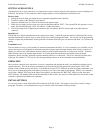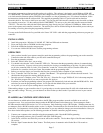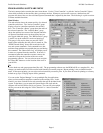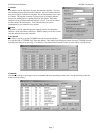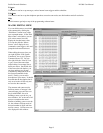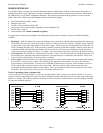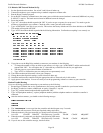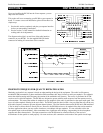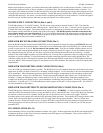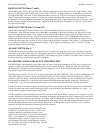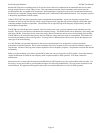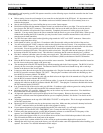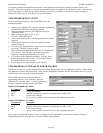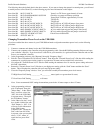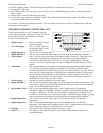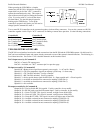
Pacific Research Solutions RI-300e User Manual
Page 12
Besides audio frequency response, you should consider the audio amplitude levels to and from the controller. If the levels to
and from the repeater are small, it may be valuable to use shielded cable. We recommend shielded cables at all times. Use
large signal levels whenever possible. On the other hand, do not let the audio signal get large enough where clipping occurs in
any stage of the controller, the receiver, or the transmitter. The RI-300 repeater controller has a built in audio level meter for
setting the RX input level. See section 7 for more details on adjusting the audio levels in the controller. Consider and practice
the above and you will have repeater audio that you and your repeater users will be proud of.
POWER SUPPLY CONNECTIONS (Pins 1 and 9)
The RI-300 operates on 12 volts DC nominal. The DC source voltage must be between 10 and 15 VDC. The controller
typically draws 140 ma. without the status LEDs turned on. Connect the +12v to J1 pin 1. Connect J1 pin 9 to ground or the 12
V return side of the power supply. The repeater builder may elect to incorporate an on/off power switch on the +DC side.
Most repeater owners switch the AC primary side of the power supply.
The RI-300 repeater controller connection to the
power supply
must be over-current protected
. Use of a one-ampere fuse should be the largest capacity considered in your
installation. A ½ amp fuse is best. When connected properly, the green LED on the status LED display will light when the
power is applied and the system enable command is on.
REPEATER RECEIVER AUDIO CONNECTION (Pin 2)
Since the RI-300 controller has the squelch (COR/COS) circuit incorporated on board, the audio input
MUST BE
connected
directly to the receiver discriminator output. Connect the receiver discriminator audio to the RI-300 J1 pin 2 and the receiver
ground or audio return to J1 pin 10.
Do
not connect to the speaker leads
. If you are not familiar with the repeater receiver,
get assistance from someone knowledgeable on the subject or contact our factory for support. If your discriminator does not
have adequate filtering for 455 kHz, you will have to provide for this filtering between the radio and controller. A 10mH
inductor in line with a 1000pF capacitor to ground should work. You may need to adjust these values according to the output
impedance of your discriminator. For best performance all audio connections should be made with a shielded cable. The
controller’s audio path has a flat frequency response from 30 Hz through 4500 Hz except for the CTCSS high pass filter that
cuts off at 300 Hz. When interfaced properly to the repeater receiver and transmitter, the controller will provide superb audio
characteristics.
REPEATER TRANSMITTER AUDIO CONNECTIONS (Pin 3)
Use a direct FM type modulator whenever possible. The RI-300 does have a de-emphasis filter that can be turned on for those
applications in which you need to interface to a modulator with pre-emphasis. It is not advisable to drive the microphone input
on the transmitters. Most microphone inputs have significant audio shaping, compensating for the microphone response and
other characteristics. Always use a shielded cable. Connect the controller transmit audio output J1 pin 3 to the input of the
modulator. Connect the modulator ground or audio return to J1 pin 10. If a FM modulator without pre-emphasis is not
available, the RI-300 can be jumped to drive a phase modulator or modulator with pre-emphasis. Do this by installing jumpers
on JP5 pins 1-2 and JP1 pins 1-2. For FM modulation, install a jumper on JP5 pins 2-3 and no jumper on JP1. See section 17
for more information on this subject.
REPEATER TRANSMITTER PTT OR TRANSMIT KEYING CONNECTION (Pin 4)
The RI-300 repeater controller keys the transmitter at the required times.
WARNING
- As with all repeater controllers, this
controller will key the transmitter at times you may not think of, such as when the ID is due. It never fails when you disconnect
the antenna to connect an in-line wattmeter, the ID goes off or a repeater user arrives on the receiver input. Therefore,
disconnect power to the repeater and controller before performing these operations. The controller PTT keying transistor sinks
current, that is, the transistor pulls to ground the relay or keying stage in the repeater transmitter. This is by far the most
common interface. Should you need to source a voltage to PTT then contact Pacific Research Solutions for application notes.
The keying transistor can sink or pull down (active low) a maximum of 120 ma of current. Connect J1 pin 4 to the repeater
transmitter PTT.
DCS MODULATION (Pin 11)
Some transmitters will not accept DCS modulation with the voice audio. In these applications, the RI-300 will output the DCS
modulation on this pin so that it can be directly connected to the DCS input on your transmitter. Please review section 7 for
additional information on this subject.



